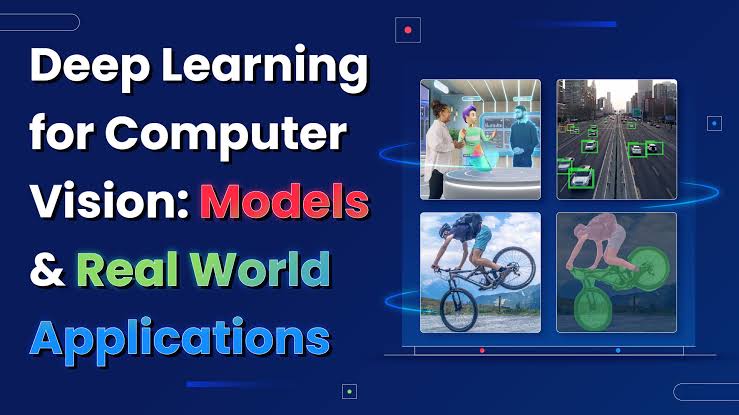Deep Learning application for Computer Vision
Deep learning has revolutionized field of computer vision. It enables machines to interpret and understand visual data with unprecedented accuracy. From facial recognition to autonomous driving deep learning applications are transforming industries and everyday life.
This article explores various applications and techniques of deep learning in computer vision. It highlights its impact and potential.
Understanding Deep Learning in Computer Vision
Basics of Deep Learning
Deep learning is subset of machine learning. It uses neural networks with many layers (deep neural networks) to model complex patterns in data. In computer vision these neural networks can learn to recognize. And interpret visual information from images and videos. They mimic the human visual system.
Key Components
The key components of deep learning models used in computer vision include convolutional neural networks (CNNs) recurrent neural networks (RNNs), generative adversarial networks (GANs). CNNs are particularly well-suited for image recognition tasks. Their ability to capture spatial hierarchies in visual data through convolutional layers is paramount.
Applications of Deep Learning in Computer Vision
Image Classification
One of the most prominent applications of deep learning in computer vision is image classification. Deep learning models can categorize images into predefined classes. This technology is widely used in various domains. Such as healthcare for diagnosing medical images. Security for identifying objects or people and social media for content tagging
Object Detection
Object detection goes beyond image classification by not only identifying objects within an image but also pinpointing their locations. This technique is essential for applications like autonomous driving, where vehicles must detect and respond to pedestrians, other vehicles, and obstacles. Popular object detection algorithms include YOLO (You Only Look Once) and Faster R-CNN.
Facial Recognition
Facial recognition technology uses deep learning to identify and verify individuals based on their facial features. This application is prevalent in security and surveillance, where it enhances access control and helps in criminal identification. It is also used in consumer electronics, such as smartphones, for unlocking devices and authenticating users.
Image Segmentation
Image segmentation involves partitioning an image into multiple segments or regions to simplify its analysis. This technique is crucial in medical imaging for identifying and analyzing different tissues, organs, or abnormalities. In autonomous driving, image segmentation helps the vehicle understand its environment by distinguishing between roads, sidewalks, and other elements.
Autonomous Vehicles
Autonomous vehicles rely heavily on deep learning for computer vision to navigate and make decisions in real-time. By processing data from cameras and sensors, deep learning models enable vehicles to recognize traffic signs, detect obstacles, and understand road conditions. This capability is critical for ensuring the safety and efficiency of self-driving cars.
Augmented Reality (AR) and Virtual Reality (VR)
Deep learning enhances AR and VR experiences by providing accurate and real-time understanding of the user's environment. In AR, it enables the overlay of digital information onto the real world, while in VR, it helps create immersive virtual environments. Applications range from gaming and entertainment to education and training.
Techniques in Deep Learning for Computer Vision
Convolutional Neural Networks (CNNs)
CNNs are the cornerstone of deep learning in computer vision. They consist of multiple layers, including convolutional layers, pooling layers, and fully connected layers. Convolutional layers apply filters to input images to extract features, while pooling layers reduce the dimensionality of the data. CNNs excel at recognizing patterns and features in images, making them ideal for tasks like image classification and object detection.
Transfer Learning
Transfer learning is a technique where a pre-trained deep learning model is fine-tuned for a new, related task. This approach is beneficial when there is limited data for the target task, as it leverages the knowledge learned from a larger, similar dataset. Transfer learning is widely used in computer vision to improve model performance and reduce training time.
Data Augmentation
Data augmentation involves creating new training samples by applying transformations such as rotation, scaling, and flipping to existing images. This technique helps improve the robustness and generalization of deep learning models by exposing them to a wider variety of data variations. Data augmentation is crucial for enhancing the performance of computer vision models, especially when dealing with limited datasets.
Generative Adversarial Networks (GANs)
GANs are a class of deep learning models that consist of two neural networks: a generator and a discriminator. The generator creates synthetic data, while the discriminator evaluates its authenticity. This adversarial process helps GANs generate highly realistic images, making them useful for applications like image synthesis, style transfer, and data augmentation.
Semantic Segmentation
Semantic segmentation assigns a label to each pixel in an image, providing a detailed understanding of the scene. Techniques like Fully Convolutional Networks (FCNs) and U-Net are commonly used for semantic segmentation. This approach is essential for applications that require precise localization and classification of objects within an image, such as medical image analysis and autonomous driving.
Reinforcement Learning
Reinforcement learning involves training an agent to make decisions by rewarding it for desirable actions and penalizing it for undesirable ones. In computer vision, reinforcement learning is used for tasks like robotic vision and control, where the agent learns to navigate and interact with its environment. This technique is particularly useful for developing AI systems that can adapt to dynamic and complex scenarios.
Challenges
Data Quality and Quantity
One of the significant challenges in deep learning for computer vision is the need for large, high-quality datasets. Collecting and annotating such datasets can be time-consuming and expensive. Addressing this challenge requires innovative approaches like synthetic data generation and active learning to reduce the reliance on large annotated datasets.
Model Interpretability
Deep learning models, particularly deep neural networks, are often considered black boxes due to their complexity. Understanding and interpreting the decisions made by these models is crucial for ensuring their reliability and trustworthiness. Developing more interpretable models and visualization techniques is an ongoing area of research.
